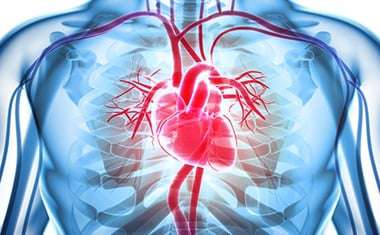Coronary artery disease, or coronary heart disease, is the leading cause of death in the United States. The disease affects more than 16 million people just in the United States. Conventional treatment methods can be effective, but there are still millions of deaths each year from this disease. The medical community needs more effective treatments and therapies in order to combat this disease.
Stem cell therapy is rapidly becoming a viable treatment option for patients with coronary artery disease. The regenerative and therapeutic properties of stem cells unlock treatment options that many researchers never thought possible. Before we get to that, let’s start from the basics to ensure you will have a better understanding of how stem cells can help patients with coronary heart disease.
What Is A Coronary Artery?
Arteries are blood vessels that circulate oxygenated and deoxygenated blood throughout the body. These vessels are extremely important in delivering all components of blood to organs and tissues. Arteries are composed of collagen fibers and elastic tissue that allow arteries to bend and fit in various places throughout the circulatory system.
Coronary arteries are responsible for pumping oxygen-rich blood to the muscle of the heart so that it can function. The arteries are also responsible for taking oxygen-deprived blood away from the heart. Any damage or blockage of coronary arteries can stop the heart muscle from pumping oxygen-rich blood to the rest of the body. When this begins to happen, the condition is known as coronary artery disease.
What Is Coronary Artery Disease?
Coronary artery disease occurs when one or all of the coronary arteries in the heart cannot pump blood to and from the heart. The most common cause of coronary artery disease is a buildup of plaque in the arteries of the heart. The plaque will create a blockage in the artery which will prevent blood from properly flowing through the heart. If left untreated, the disease can lead to heart attacks and strokes. Additionally, the plague buildup can break off and form a blood clot.
The heart does respond to the blocked coronary arteries. When the plaque builds up to a point where blood flow is blocked or restricted, the body will enable a condition called collateral circulation. When this occurs, a group of tiny collateral blood vessels will enlarge. This will enable the heart to continue to circulate blood through the heart. However, this condition does not properly replace the ability of coronary arteries.
Over time disease will wosen, which can lead to a number of deadly conditions. Patients need to seek out treatment as soon as they experience any symptoms.
Current Treatment Methods
As the leading cause of death in the United States, there are a number of treatment methods for patients with coronary artery disease. Sadly, some patients do not respond to any of the treatment methods that are currently available.
Medications
There are a number of medications that have been developed to treat coronary artery disease. These medications can reduce cholesterol, blood pressure, blood sugar, and the clotting ability of the blood. The lower levels of these factors will help prevent plague from building up on the walls of coronary arteries.
LifeStyle Changes
Incorporating more exercise and healthy foods into a patient’s daily routine can improve the progression of the disease. Reducing tobacco and alcohol consumption are also key to improving a patient’s outlook. Patients who do incorporate lifestyle changes have a decreased risk of stroke and heart attack. However, the underlying plaque buildup in the arteries will not be addressed by only changing a patient’s lifestyle.
Surgeries
Coronary artery graft bypass surgery is one of the most well-known surgeries in the world and is used to treat coronary artery disease.The surgery aims to use blood vessels taken from another part of your body to bypass the damaged arteries. There are about 200,000 of these surgeries performed each year in the United States. A patient could have up to four coronary arteries replaced during the surgery.
The short-term outcomes for patients that have successful bypass surgery are very good.
The long-term outcomes should concern patients who have received the surgery. After 8-10 years, the mortality of patients who have received the surgery is between 60-80%.
Researchers theorize that the reasoning behind this trend is that coronary artery disease continues to progress or the implant material begins to fail.
Angioplasty is another surgical method that is often used to treat coronary artery disease. This method treats the plaque buildup in an artery by utilizing a miniature balloon. A surgeon will insert a tube into a vein and to the artery where the plaque buildup is. The balloon can then be inflated to push the plaque up against the artery wall.
For many patients medication and surgery are not enough to prevent the disease from progression. They are often left with few to no options to prevent the disease from continuing to progress. Thankfully, researchers have begun to turn to stem cells to find new innovative therapies to treat coronary artery disease.
How Would Stem Cells Help Coronary Artery Disease?
The main cause of coronary artery disease is plaque buildup in the arteries. Angioplasty does not solve the underlying plaque buildup, it only squishes the plaque against the artery walls. Stem cells may have the ability to help eliminate the plaque buildup in the arteries. The goal of newly developed therapies should be repairing arteries and reducing plaque buildup.
Researchers believe that inflammation is one of the main causes of plaque buildup in arteries. Stem cells have anti-inflammatory properties that would discourage more inflammation in the arteries from developing. The hope would be that decreased inflammation would mean less plaque buildup over time. Researchers are also optimistic that stem cells can even help the body break down plaque in coronary arteries.
Stem cells can release immunosuppressive and anti-angiogenic agents. These agents will encourage the body to prevent further plaque buildup and potentially break down the plaque buildup present. Researchers are actively conducting studies that are pointing to the fact that stem cells therapy could be an effective treatment for patients with coronary heart disease.
Stem Cell Therapy for Coronary Artery Disease
There are a number of studies that showcase how effective stem cells can be in treating coronary artery disease.
Successful Dutch Study
In the Netherlands, a study recently took place where 50 patients who had coronary artery disease received bone marrow stem cell injections into their hearts to try and combat the disease. The patients had run out of treatment options and their conditions continued to deteriorate. One group of patients received bone marrow stem cells, while the other group received inactive cells.
The group that received bone marrow stem cells drastically improved. Some patients had complete relief from their chest pain and symptoms, while others reported partial benefits
Incredibly, the amount of blockage in the arteries were cut in half. That is a fantastic result for patients with no other treatment options. The study was so successful that the patients who did not receive the bone marrow stem cells received them after the study.
Researchers are not entirely sure how the stem cells are able to drastically reduce blockage in the arteries. Some believe that the stem cells enable the body to grow new blood vessels, while others theorize that the stem cells help the existing arteries eliminate the blockage. Whatever the mechanisms, the study is a successful example of how stem cells can be used to treat patients with coronary artery disease.
Combining Other Treatments With Stem Cell Therapy
One study utilized silica-gold nanoparticles in addition to stem cells in order to eliminate plaque in coronary arteries. 39 pigs with coronary artery disease were the test subjects in this study. They received an injection of the nanoparticles into the area with the plaque buildup. The nanoparticles were then activated with laser light and the nanoparticles effectively burned away the plaque. 19 pigs received the nanoparticles and stem cell injections via various methods. The remaining 18 pigs only received saline solution.
Immediately after the procedure, the plaque volume decreased by 28.9% and six months later the plaque volume decreased by 56.8%. The group that received only a saline solution plaque volume decreased by only 4.3%. The nanoparticle treatment that incorporated stem cells was the most effective at eliminating plaque buildup.The added benefit of the stem cells helped the body repair the coronary arteries from the damage that occurred from the plaque buildup.
Growing New Arteries?
Another potentially exciting use of stem cells is to grow completely new arteries. At a certain point, a damaged coronary artery may not be able to be repaired using stem cell therapy. At a certain point there might simply be too much damage to the artery. Researchers have long hoped that stem cells would one day be able to grow completely new organs.
Stem cells may have the ability to grow into new arteries for patients. The end goal for the medical community would be similar to a blood bank. The artery bank would make artery material readily available for patients who are undergoing surgery. These stem-cell grown arteries will have almost no chance of being rejected by the patient’s body. Growing new arteries is a technology that is likely years away, but the research is promising.
Stem cell therapy is likely going to play a large part in how the medical community treats coronary artery disease going forward. Keep a lookout for future developments for stem cell therapies for coronary artery disease.


